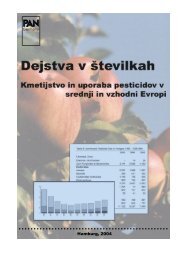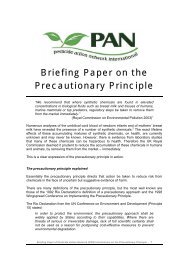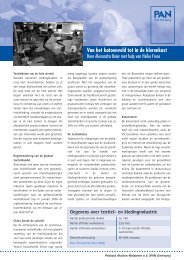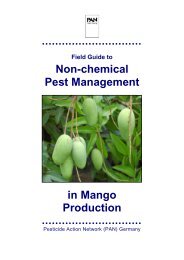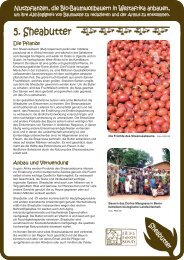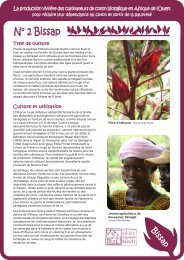Field Guide: How to Grow Crops without Paraquat - Online ...
Field Guide: How to Grow Crops without Paraquat - Online ...
Field Guide: How to Grow Crops without Paraquat - Online ...
Create successful ePaper yourself
Turn your PDF publications into a flip-book with our unique Google optimized e-Paper software.
<strong>Field</strong> <strong>Guide</strong>: <strong>How</strong> <strong>to</strong> Live and Work Without <strong>Paraquat</strong><br />
Methods of control<br />
1. Proper seed selection<br />
2. Use seeds that are Striga seeds-free. Avoid using<br />
seeds from the previous harvest if the crops were<br />
infested with Striga. Buy the seeds for your next<br />
cropping from an agricultural seed s<strong>to</strong>re in your<br />
locality.<br />
3. Regular plant moni<strong>to</strong>ring<br />
4. Intercropping sorghum with cowpea<br />
5. Intercropping corn with silver leaf desmodium<br />
(Desmodium uncinatum) or green leaf desmodium<br />
(D. in<strong>to</strong>rtum). Desmodium is a leguminous plant<br />
that is a good source of fodder for the farm<br />
animals. When planted as an intercrop, it covers<br />
the surface in between the rows of the main crop<br />
(corn, sorghum, or millet). Desmodium emits<br />
chemical in<strong>to</strong> the soil that is unfavorable for<br />
Striga's growth. 2.5 kg of seeds are needed for 1<br />
ha.<br />
6. Hoeing and hand weeding before Striga plants<br />
start <strong>to</strong> flower. Late weeding requires the burning<br />
of collected plants <strong>to</strong> kill the seeds. Never put<br />
them in your compost pile or pit.<br />
7. Off-barring and hilling-up the rows<br />
8. Apply both organic and inorganic fertilizers <strong>to</strong><br />
improve the crop's stand.<br />
9. Crop rotation with legumes such as soybean,<br />
mungbean, and other leguminous crops, <strong>to</strong><br />
improve the soil condition and deprive the<br />
parasitic weeds from favored host plant<br />
Water hyacinth<br />
Scientific name: Eichhornia crassipes<br />
Synonyms: Witchweed<br />
Habitat<br />
Freshwaters<br />
Affected crops<br />
Mostly irrigated rice<br />
Distribution<br />
Worldwide<br />
Description<br />
The stem is erect and bears the flowers. The flowers<br />
are blue-violet or lilac, large, and attractive. They have<br />
six petals and one bears a yellow spot. The leaves are<br />
green <strong>to</strong> dark-green, round <strong>to</strong> oval, and glossy with<br />
leathery blades. The leafstalks (petioles) are thick and<br />
spongy and contain some amounts of air that enable<br />
the plant <strong>to</strong> float. Masses of fine branching roots hang<br />
underneath the floating plant. The plant is propagated<br />
by seeds and vegetative offshoots.<br />
The weed forms a dense mat that interferes with the<br />
flow of water in irrigation canals and serves as a<br />
breeding ground for mosqui<strong>to</strong>es. It competes with rice<br />
for soil nutrients reducing the yield when left<br />
uncontrolled. Water hyacinth is the most damaging<br />
aquatic plant worldwide.<br />
Methods of control<br />
1. Proper soil tillage and/or thorough land preparation<br />
2. Hand weeding. Water hyacinth can be used as<br />
feed <strong>to</strong> swine and water buffaloes (carabaos),<br />
mulch, and compost material<br />
3. Regular plant moni<strong>to</strong>ring<br />
4. Rotate rice with legumes<br />
5. Biological control with the use of weevils, Neochitina<br />
eichhorniae and N. bruchi. Ask for<br />
assistance from your local agricultural office for<br />
more information on this control measure.<br />
•••••••••••••••••••••••••••••••••••••••••••••••••••<br />
26 Pesticide Action Network (PAN) Germany



